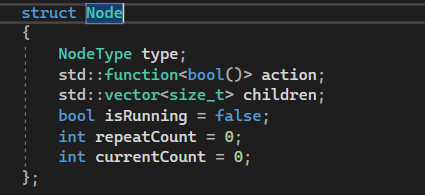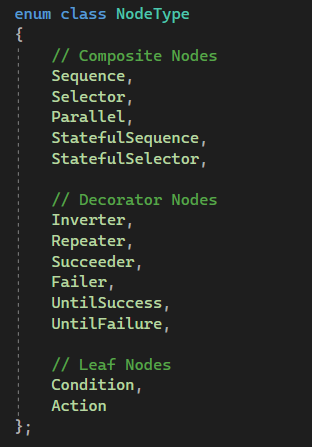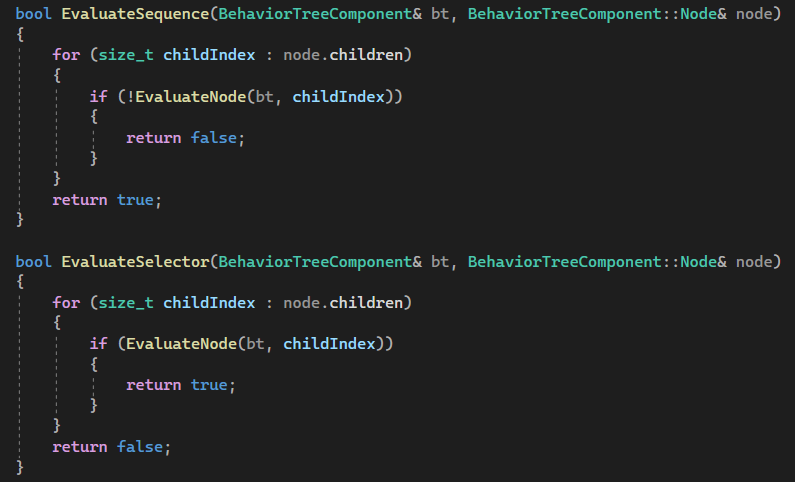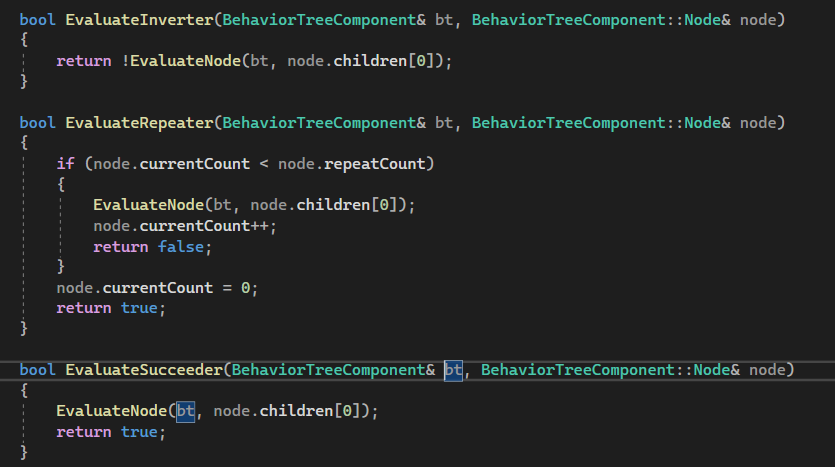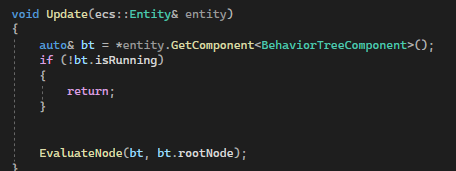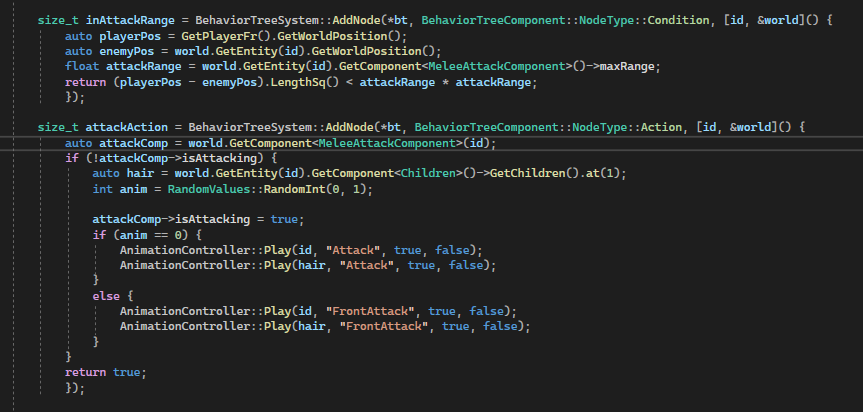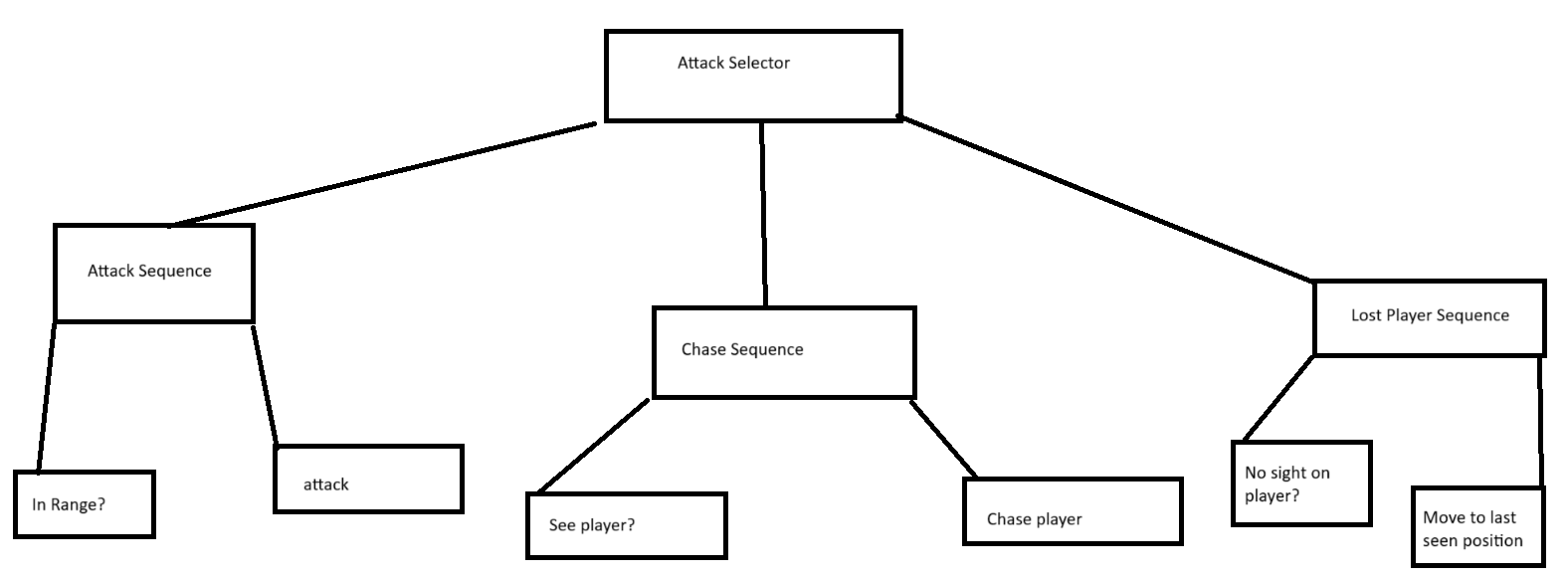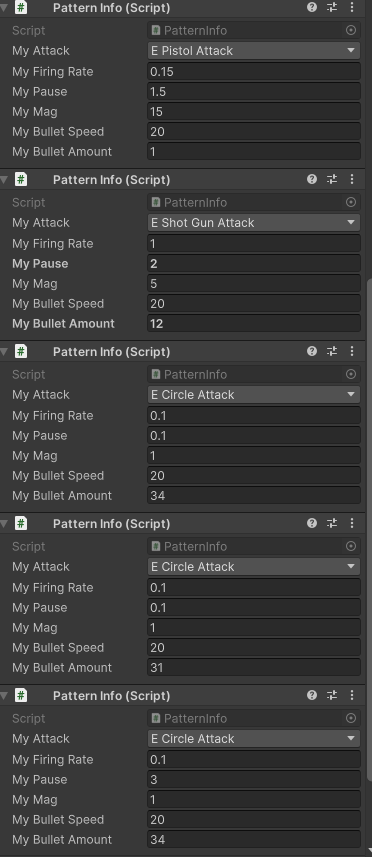Welcome To my Portfolio
Behavior Tree
For my specialization, I chose to work on my own Behavior Tree. The reason behavior trees interest me is that they allow for easy AI setup and debugging, with every behavior simply being a node in the tree's hierarchical structure. To add a behavior, all it takes is adding a node.
I implemented this in our engine, Tonic Engine, which uses its own ECS (Entity Component System), created by William Arnberg (Check portfolio [here]).
A behavior tree follows a hierarchical tree structure, where we program and design each node to represent a specific behavior or action. The execution starts at the root node and activates the child nodes left to right.
The behavior tree consists of a list of nodes, with each node representing a behavior. The root node starts at index 0 and checks whether the tree should be running. Each node has:
A Node Type, defining the node's role.
A std::function to store the action or behavior (only used by leaf nodes).
A vector of children, allowing composite or decorator nodes to be linked to their child nodes.
Additional variables to handle execution states.
Here are the different types of nodes:
Composite nodes are the ones that control the flow of the execution.
Decorator Nodes allow us to modify the child nodes.
Leaf Nodes perfoms the action or checks to see if we fail or succeed,
Each node has its own logic and functions that we evaluate to determine how it should act based on the results.
Composite
A sequence goes through the children in order, if one fails we return false, if all succed then we return true.
A Selector will run through all the children and return true if any of them succed, If all fail then we return false.
Decorator
Inverter inverts the result of its child.
Repeater will run its child a number of times that we set before returning true
Succeeder always runs true, no matter what the result of the child is
Leaf
The End points of our tree, the goal the tree tries to reach.
Condition: Check if a certain condition is met
Action: Perfom a specific action that we either return true or false on.
We can easily add our nodes, by giving it the type.
We send in the specific entity’s component we want to add it on
Sending in function (specifically for leaf nodes). Adding a function for other node types should be avoided, same with adding a children list for leaf nodes
The update loop starst by sending in the rootnode and only runs if allowed.
The Evaluate Node determines what action it should take, using recursion to evaluate child nodes until a leaf node is reached, then it executes the leaf nodes
We’ll use this system to construct a tree for the enemies in Project 7, which were intentionally simple. Each enemy’s behavior is initialized in their Init() function. Here’s how it works:
1 Selector Node (Root)
3 Sequence Nodes (Attack, Chase, Find Player)
The Selector (root) decides which behavior to execute, while the Sequences ensure actions are performed only if their conditions are met.
Each leaf node (condition/action) is defined using lambda functions (inline, nameless functions). For example:
CanAttackCondition(Lambda): Checks if the player is in range.AttackAction (Lambda): Executes the attack animation.
If
CanAttackConditionfails, the entire sequence aborts, skippingAttackAction.
Since we’re using a Selector as the root node:
It will check children left-to-right (Attack → Chase → Find Player).
The first sequence that succeeds runs, and the rest are ignored.
If all fail, the selector returns false (though we don’t currently use this output).
With all of these put together we will have a tree looking like this->>>>>>>>>>>>>>>>>>>>>>>
Using a Selector as our root is good because we avoid unnecessary checks and prioritize the behaviors that we want to prioritize.
While our current tree is simple, we could add a fallback behavior. For example a wander behavior if our attack selector fails. Use subtrees for low health enemies. If we really wanted to, the tree could scale to 100+ nodes.
The important thing to keep in mind is that the tree should consist of single-responsibility nodes. Everything should have descriptive names. Behavior trees help us: Behavior trees helps us to isolate failures by checking the nodes and Add/Remove behaviors without rewriting the entire AI.
He is behaving
Excuse my paint skills
Game Projects
In the end of my education, I will have been a part of 8 different projects in The Game Assembly. From working in Unity to the school’s engine (TGE) and finally to our own engine (Engine o Tonic), I have been grateful for this experience, which has taught me the process of game development. Here are some of my favorite projects.
Fika Frenzy
..the greatest game ever made
Project 8 — our last project at TGA, and my final project as part of Bullens Pilsners Studio (no trademark). I can only wish the best of luck to every member who was part of this journey. I’ll never forget the fun times we had creating these games!
A special thanks as well to the talented people from AP Academy, who helped us with some awesome audio and music. Try it yourself at https://phewdoge.itch.io/fika-frenzy
Game Engine:
Engine o tonic
Duration :
8 weeks, 100%
Contributions:
Gameplay
Portals
One of the key gameplay elements in our game is the interactive portals scattered around the maps. They allow players to engage in cross-map combat and initiate surprise attacks.
Anti Camper Swatter
Through our multiple team-building sessions, which consisted of us playing several games of rounds, we discovered that some players tended to avoid the constant action by hiding and staying away from combat.
Our solution to this problem is a small fly that helps us catch these “campers.” By saving each player’s position and using the last ten as a reference, we can compare their movement to a threshold to determine if a player has been hiding for too long.
Shield
Inspired by Rounds’ block mechanic, our game features a bubble shield that allows you to redirect opposing players’ bullets. Time it correctly, and you’ll be rewarded with even more!
Upgrades
Our game is driven by the upgrade system, where players can choose a new upgrade if they lose a round.
Here are a few that I worked on: Explosive Bullets and the Brawler card.
First Person Experience:
AI Quit
Game Engine:
Engine and Tonic
Duration :
15 weeks, 50%
Contributions:
Enemies
Simple Enemies using their own Behavior trees, satisifying to beat up.
Melee Enemy, Static Range Enemy and a Range Enemy (Not Shown).
More Enemies!
Seperation
From the beginning of Project 7, we decided our game wouldn’t need a traditional navmesh for enemy pathfinding.
Using the Jolt Physics library (implemented by Gustaf Engsner (Check portfolio [here])), we leveraged its shape casting system to cast 8 directional rays around each enemy. As Gustaf put it:
"All we need is some separation steering."
The result? Enemies evolved from getting stuck on chairs to smoothly navigating around corners.
In the demo video, we spawn VFX markers at each shape-cast hit point, revealing what position the AI is avoiding.
While not perfect (some edge cases still haunt us), we mitigated issues by:
Letting enemies step over small objects
Designing levels to avoid tight spaces
Tweaking separation force for better collision response
This was a fun, iterative process—one I’d love to refine in future projects!
Top Down Adventure:
Spores of Malice
Boss Patterns
In collaboration with Sebastian Dahlskog(Check portfolio [here]), a fully customizable boss pattern script that we used to export to TGE. Allowing our level designers to pick what attack they wanted to use, how many times and the pause time in between attacks.
Bosses runs through the list of patterns given making for some exciting boss fights.
Game Engine:
TGE (The Game Assembly’s home built engine)
Duration :
7 weeks, 50%
Contributions:
Enemies, Bosses,
Enemies and Weapon factory
Our bosses uses the weapon implementation used for our basic enemies for their attacks. Each enemy using A* pathfinding, gaining their weapons type from a factory. The key part of what Level Design wanted was ajdusting reload speed for each enemy, which gave them more freedom for game design
Endless Runner:
Beaver Fever
Game Engine:
Unity
Duration :
5 weeks, 50%
Contributions:
Camera, Collisions and Scene Transition
My first project in The Game Assembly and the shortest project. Being new to unity, learning C# was a challenge in the beginning. Implemented a camera to match the same camera used in our reference game.
Learned how to do animations in Unity, which allowed me implement a quick little scene transition
Other Game Projects and Contribution
Mobile Puzzel Game
Detective Rodent
Game Engine:
Unity
Duration:
5 weeks, 50%
Contribution:
UI
Platformer
Ghost in the shield
Game Engine:
TGE (The Game Assembly’s home built engine)
Duration:
12 weeks, 50%
Contribution:
Gameplay
Action RPG
Spite: The Infernal Oath
Game Engine:
Tonic Engine
Duration:
10 weeks, 50%
Contribution:
Gameplay
About Me
My journey into programming began in high school at LBS Kreativa, where I was first exposed to coding. While I didn’t particularly enjoy web design and web development, I discovered that the problem-solving and logical thinking involved in programming were fun, so continuing to learn was at the top of my list after graduation. With my passion for games and a desire to continue learning, pursuing a degree in game programming was a natural choice, as it allowed me to both understand and contribute to the development of games. I'll admit that it was intimidating at first, with so much to learn and so many people in my year who already had experience making games. I often felt overwhelmed. Fortunately, I had the opportunity to work alongside some truly amazing people from whom I could learn.
I have experience in other programming languages, like Python and Java. Personally, I would consider my main language to be C++, as that was what was taught during my two years in The Game Assembly. I do consider myself more of a gameplay programmer, as that’s what I enjoy the most and is the area I have worked in the most during all my school projects. However, I’m willing to work with, and have worked with, UI and systems before.
Programming isn’t my only hobby, however. I enjoy games, especially competitive games. Whether it’s fighting games like Tekken or Street Fighter, or team-based games like Rivals or Team Fortress, games that promote self-improvement and extensive game knowledge to get better will always interest me.
I’m also the biggest wrestling fan. I've traveled to events and regularly host watch-alongs with my friends to enjoy the fascinating and thrilling world of pro wrestling. AEW, WWE, or NJPW—it doesn’t matter; I can talk about it all day.



